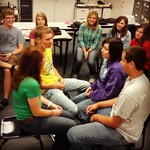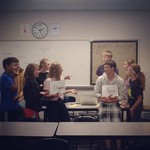Classroom Discussion Strategies
Classroom Discussions play an important role in student learning. It engages students, allows them to practice important life skills and is also a form of assessment. I rely on these interactions to help me gauge student understanding of topics we are studying. The following are a few of my favorite, and more unique, discussion strategies. Many of these ideas have been borrowed and modified for my own classroom.
First Things First –
Establish classroom guidelines for discussions. Ask students for input; they always have great ideas. Limit guidelines to 5 or fewer and use accessible language for all students. Here are my guidelines, along with brief explanations:
1. No Hands – when discussing, students must negotiate their own time and not speak over each other. They are speaking to EVERYONE in the classroom, not just to me.
2. Stay on Topic – although I love when discussions grow organically, if Ophelia’s death quickly turns to school gossip I step in and refocus the group if a student hasn’t already.
3. Disagree with the Comment, DO NOT attack the person – Differing opinions makes life interesting and classroom discussions fruitful.. One of the most difficult things for students to understand is another student’s TRUTH is just as right and as strong as their own TRUTH.
4. No yelling, swearing, throwing chairs, etc. – I teach AP Literature. Our discussions often lead to religion, politics, gender, etc. and can get heated. These rules are necessary for the safety and climate of the classroom.
5. Ends at the Bell – nothing excites me more than when students are still talking about the class as they walk out the door, toppling into lunchroom conversations or is brought up at home with parents; but, students are not to use anything that was said in the discussion in a negative way, wether in a different class or on the athletic field. We all agree to disagree.
Strategies
1. Fishbowl Tap-out 
*4 chairs placed in the middle of the room, while all students form an outside circle around the center group, thus forming a “fishbowl” effect.
*The 4 students sitting in the middle are the only ones allowed to speak. They are having a discussion with each other about topics at hand or what they read.
*If an outside circle student wishes to speak they must “tap-out” (on the shoulder) one of the 4 people. That person must stand and move to the outside circle. There is no refusing to leave once tapped-out.
*Students on the outside can be listening, backchanneling on a TodaysMeet, or taking notes on paper.
TIPS – Students should try to be in the “hot seat” at least once during the discussion, allow students 2 min. minimum before being tapped out, teacher may have to ask a question if discussion is stalling (otherwise they are a silent observer as well)
2. Body Voting 
*Provide students with a list of statements. Have them silently go through each one marking if they “Agree” or “Disagree”.
*Designate opposite areas in the classroom as “Agree” and “Disagree” zones
*Teacher reads the statement and students move to the area that represents their response.
*Discussion can ensue in a team-like fashion.
TIPS – This strategy takes up a lot of time, have students mark on their paper the top 3 or 4 statements they would like to discuss. Give students one minute to organize thoughts and points as a group before starting discussion. Make students choose a side, there is no neutral.
3. SSC (Small Silent Collaboration)
*Divide students into small groups – no more than 4 per group works best.
*Have one student create a gdoc or typewithme and share with the group members AND the teacher.
*Students silently type important topics from their reading, questions they had, surprises from the passage, etc.
*Teacher monitors all group writing noting important discussion topics found in each.
*After a designated time, students discuss as a large group. The teacher has all the student- driven discussion topics in hand.
TIPS – Typewithme allows students to join under any name, be careful in large groups. This strategy allows every student to have a “voice” which is unique for the teacher to see.
These strategies are a few of the more “unique” ones I use in my classroom. They are also the most effective in engaging students and encouraging participation!





“Body voting” is similar to a technique I use in my elementary Spanish classes. I project two images on the wall and say in Spanish the name of one of the objects and ask the younger students to move to the side of the room that shows the word I used. Similarly I project images of food or activities and the students move to the I like or I don’t like side of the room and take turns saying in Spanish, I like or I don’t like.
Joseph McCright
January 26, 2013 at 1:55 pm
Reblogged this on Shaelynn Farnsworth and commented:
A post from my previous blog. Classroom Discussions, important things to consider.
sfarnsworth
December 31, 2013 at 3:15 am